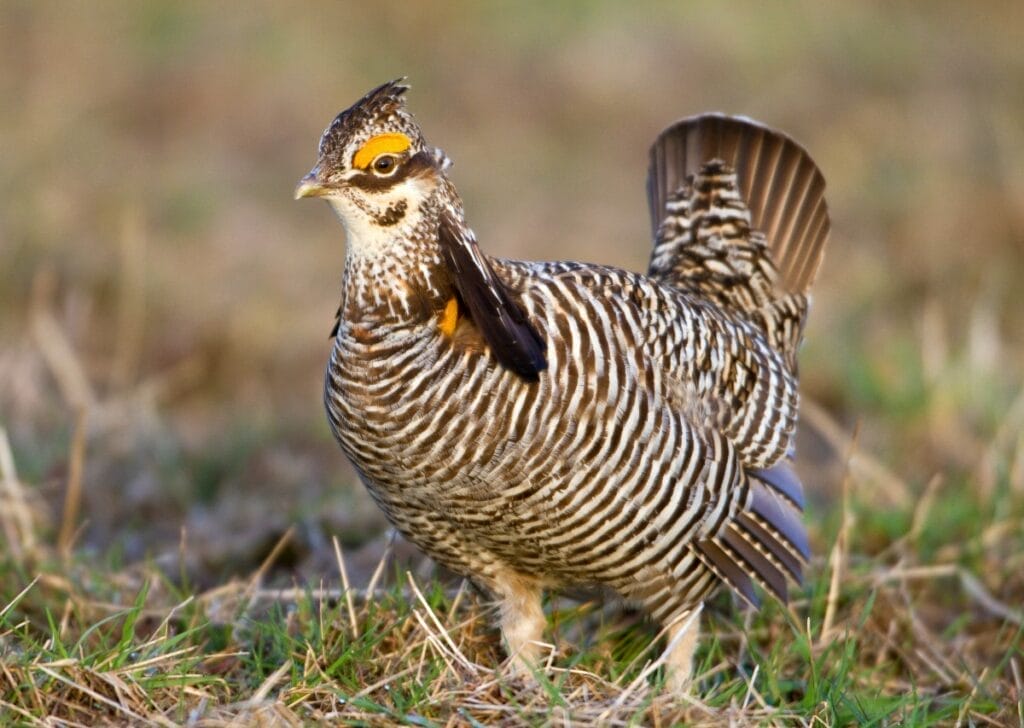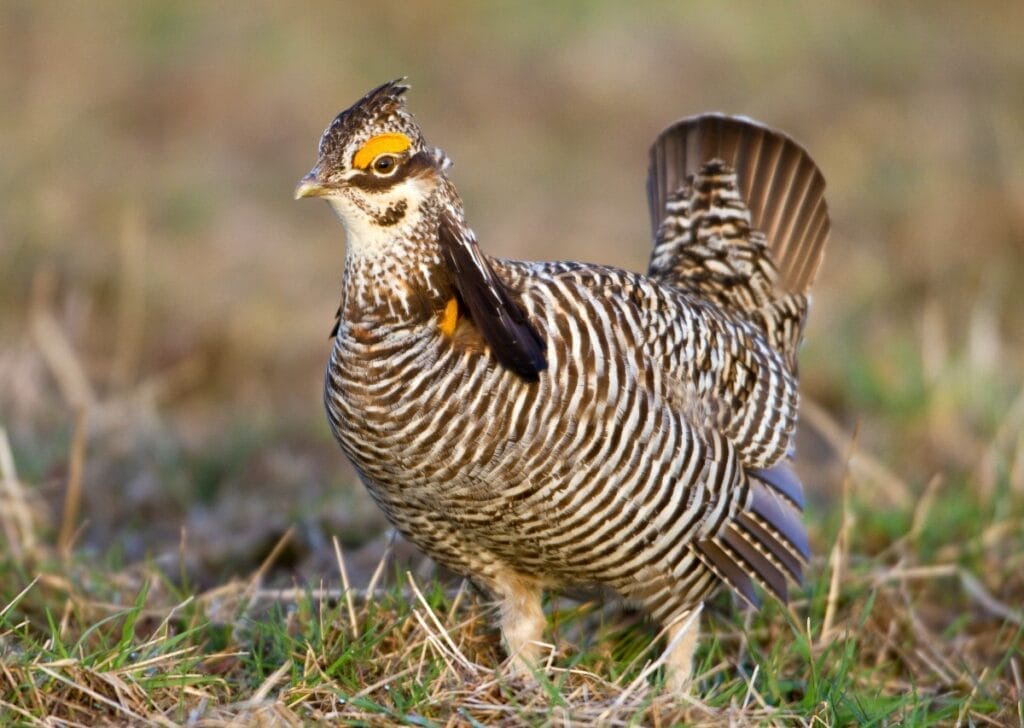This post originally appeared at https://www.badgerinstitute.org/prairie-chickens-and-the-land-eating-solar-industry/
“Why should we destroy our environment just so the big cities can have power?”

Who would have guessed that the greater prairie-chicken is the sort to get all NIMBY in Wisconsin’s declared war against carbon dioxide? Yet there they are, rightly flustered that a giant swath of solar panels might end up in their Portage County prairie.
A flock of hunters and bird-watchers, speaking in defense of the chickens, have complained to the Wisconsin Public Service Commission about the proposed Vista Sands Solar project just east of Wisconsin Rapids, saying it would ruin a stronghold of the now-threatened bird.
The prairie-chickens most likely would just vanish — or, as the Dane County Conservation League pointed out to the PSC, get eaten by avian predators perching on miles of new fencing around what is now unparalleled paradise for a threatened bird once common when the Midwest was mostly wild grassland.
Miles of fencing, indeed: The project’s scale elevates it from “solar farm” to, perhaps, solar plantation: At 7,100 acres, it would be Wisconsin’s largest, taking up as much land as the City of West Allis, filling 11 square miles with millions of solar panels. Add in an already-approved solar project just to the north, and you’re at about 10,000 acres of solar panels — the size of the cities of Racine or Stevens Point.
Conservation groups want it to take up less, perhaps a quarter to a third less. The Wisconsin Society for Ornithology, for instance, wants buffer zones near existing state-owned land. The Wisconsin Wildlife Federation said no solar panels should be within a mile of the birds’ mating grounds. Most hasten to add that they’re all aboard the solar-power train; they just wish it didn’t deliver them to a sort of vast, artificial forest right by the home of a species that at all costs avoids forests or anything else tall.
Millions of panels
The state already owns about 12,700 acres of the prairie south of the planned solar site, though in scattered pieces, and the Dane County Conservation League has been buying land in the area since the 1950s to preserve it for wildlife. It now owns 4,300 acres. It’s a measure of Vista Sands Solar’s size that the league said it nonetheless “has the potential to destroy our 75-year commitment.”
This inadvertently points out an underappreciated reality: “Renewable” power such as wind and solar might not use fuel, but they use a lot of land, and solar uses it exclusively.
Some of Vista Sands’ potential neighbors were among the first to object to the PSC on the grounds that what happened immediately beyond their property line affected their habitat, too.
“The solar array will be located all around the property,” wrote one landowner. “These arrays will stand quite high, destroying any views.” She added: “Just because we are in a rural area doesn’t mean we will have to adapt to it, having these arrays pushed on us. … Why should we destroy our environment just so the big cities can have power?”
Another neighbor objected to the high-voltage transmission lines, writing, “Nobody wants to live under or adjacent to transmission lines of this magnitude.” The project’s developers later seem to have agreed to bury some of those lines, conceding his point, but they can’t bury the more than 2 million panels, meaning that neighbors are right: What had been a rural area is being turned an industrial one.
That happens, but usually it’s a dozen acres here or there for a factory or a sand quarry. Here, it’s 11 square miles. Is it for something worth that much land?
Clouds over the panels
The project is billed as being able to generate 1,300 megawatts — just a notch more than Point Beach Nuclear Plant north of Two Rivers for comparison. Point Beach does it on a site one-sixth the size.
But it is almost certain Vista Sands won’t generate as much electricity over time as Point Beach because, as Badger Institute pointed out recently, while Point Beach reliably provides about as much electricity as it’s capable of, utility-scale solar plantations in Wisconsin manage only about 17% of their “nameplate” or maximum potential capacity. Clouds and winters happen.
Take the experience of Wisconsin’s biggest existing solar installation, Badger Hollow, west of Dodgeville, fully operational as of this year. Its capacity is 300 megawatts, about a fourth of Point Beach. According to the federal Energy Information Administration, through the first five months of this year, it generated not 25% as much power as Point Beach — but about 3.6% as much.
Meaning that if solar power, which in the latest federal figures produced 0.8% of Wisconsin utilities’ electricity, is going to replace the 35% produced by coal, there’s going to be a lot more of rural Wisconsin covered in solar panels — much more than facile math with “nameplate capacity” would suggest.
Prairie-chickens and rural Portage County residents won’t be the only ones finding their back yards being turned into industrial sites.
Patrick McIlheran is the Director of Policy at the Badger Institute. Permission to reprint is granted as long as the author and Badger Institute are properly cited.
var gform;gform||(document.addEventListener(“gform_main_scripts_loaded”,function(){gform.scriptsLoaded=!0}),window.addEventListener(“DOMContentLoaded”,function(){gform.domLoaded=!0}),gform={domLoaded:!1,scriptsLoaded:!1,initializeOnLoaded:function(o){gform.domLoaded&&gform.scriptsLoaded?o():!gform.domLoaded&&gform.scriptsLoaded?window.addEventListener(“DOMContentLoaded”,o):document.addEventListener(“gform_main_scripts_loaded”,o)},hooks:{action:{},filter:{}},addAction:function(o,n,r,t){gform.addHook(“action”,o,n,r,t)},addFilter:function(o,n,r,t){gform.addHook(“filter”,o,n,r,t)},doAction:function(o){gform.doHook(“action”,o,arguments)},applyFilters:function(o){return gform.doHook(“filter”,o,arguments)},removeAction:function(o,n){gform.removeHook(“action”,o,n)},removeFilter:function(o,n,r){gform.removeHook(“filter”,o,n,r)},addHook:function(o,n,r,t,i){null==gform.hooks[o][n]&&(gform.hooks[o][n]=[]);var e=gform.hooks[o][n];null==i&&(i=n+”_”+e.length),gform.hooks[o][n].push({tag:i,callable:r,priority:t=null==t?10:t})},doHook:function(n,o,r){var t;if(r=Array.prototype.slice.call(r,1),null!=gform.hooks[n][o]&&((o=gform.hooks[n][o]).sort(function(o,n){return o.priority-n.priority}),o.forEach(function(o){“function”!=typeof(t=o.callable)&&(t=window[t]),”action”==n?t.apply(null,r):r[0]=t.apply(null,r)})),”filter”==n)return r[0]},removeHook:function(o,n,t,i){var r;null!=gform.hooks[o][n]&&(r=(r=gform.hooks[o][n]).filter(function(o,n,r){return!!(null!=i&&i!=o.tag||null!=t&&t!=o.priority)}),gform.hooks[o][n]=r)}});
Submit a comment
“*” indicates required fields
/* = 0;if(!is_postback){return;}var form_content = jQuery(this).contents().find(‘#gform_wrapper_21’);var is_confirmation = jQuery(this).contents().find(‘#gform_confirmation_wrapper_21’).length > 0;var is_redirect = contents.indexOf(‘gformRedirect(){‘) >= 0;var is_form = form_content.length > 0 && ! is_redirect && ! is_confirmation;var mt = parseInt(jQuery(‘html’).css(‘margin-top’), 10) + parseInt(jQuery(‘body’).css(‘margin-top’), 10) + 100;if(is_form){jQuery(‘#gform_wrapper_21’).html(form_content.html());if(form_content.hasClass(‘gform_validation_error’)){jQuery(‘#gform_wrapper_21’).addClass(‘gform_validation_error’);} else {jQuery(‘#gform_wrapper_21’).removeClass(‘gform_validation_error’);}setTimeout( function() { /* delay the scroll by 50 milliseconds to fix a bug in chrome */ jQuery(document).scrollTop(jQuery(‘#gform_wrapper_21’).offset().top – mt); }, 50 );if(window[‘gformInitDatepicker’]) {gformInitDatepicker();}if(window[‘gformInitPriceFields’]) {gformInitPriceFields();}var current_page = jQuery(‘#gform_source_page_number_21’).val();gformInitSpinner( 21, ‘https://e74sq7k37a8.exactdn.com/wp-content/plugins/gravityforms/images/spinner.svg’, true );jQuery(document).trigger(‘gform_page_loaded’, [21, current_page]);window[‘gf_submitting_21’] = false;}else if(!is_redirect){var confirmation_content = jQuery(this).contents().find(‘.GF_AJAX_POSTBACK’).html();if(!confirmation_content){confirmation_content = contents;}jQuery(‘#gform_wrapper_21’).replaceWith(confirmation_content);jQuery(document).scrollTop(jQuery(‘#gf_21’).offset().top – mt);jQuery(document).trigger(‘gform_confirmation_loaded’, [21]);window[‘gf_submitting_21’] = false;wp.a11y.speak(jQuery(‘#gform_confirmation_message_21’).text());}else{jQuery(‘#gform_21’).append(contents);if(window[‘gformRedirect’]) {gformRedirect();}}jQuery(document).trigger(“gform_pre_post_render”, [{ formId: “21”, currentPage: “current_page”, abort: function() { this.preventDefault(); } }]); if (event && event.defaultPrevented) { return; } const gformWrapperDiv = document.getElementById( “gform_wrapper_21” ); if ( gformWrapperDiv ) { const visibilitySpan = document.createElement( “span” ); visibilitySpan.id = “gform_visibility_test_21”; gformWrapperDiv.insertAdjacentElement( “afterend”, visibilitySpan ); } const visibilityTestDiv = document.getElementById( “gform_visibility_test_21” ); let postRenderFired = false; function triggerPostRender() { if ( postRenderFired ) { return; } postRenderFired = true; jQuery( document ).trigger( ‘gform_post_render’, [21, current_page] ); gform.utils.trigger( { event: ‘gform/postRender’, native: false, data: { formId: 21, currentPage: current_page } } ); if ( visibilityTestDiv ) { visibilityTestDiv.parentNode.removeChild( visibilityTestDiv ); } } function debounce( func, wait, immediate ) { var timeout; return function() { var context = this, args = arguments; var later = function() { timeout = null; if ( !immediate ) func.apply( context, args ); }; var callNow = immediate && !timeout; clearTimeout( timeout ); timeout = setTimeout( later, wait ); if ( callNow ) func.apply( context, args ); }; } const debouncedTriggerPostRender = debounce( function() { triggerPostRender(); }, 200 ); if ( visibilityTestDiv && visibilityTestDiv.offsetParent === null ) { const observer = new MutationObserver( ( mutations ) => { mutations.forEach( ( mutation ) => { if ( mutation.type === ‘attributes’ && visibilityTestDiv.offsetParent !== null ) { debouncedTriggerPostRender(); observer.disconnect(); } }); }); observer.observe( document.body, { attributes: true, childList: false, subtree: true, attributeFilter: [ ‘style’, ‘class’ ], }); } else { triggerPostRender(); } } );} );
/* ]]> */
The post Prairie-chickens and the land-eating solar industry appeared first on Badger Institute.
